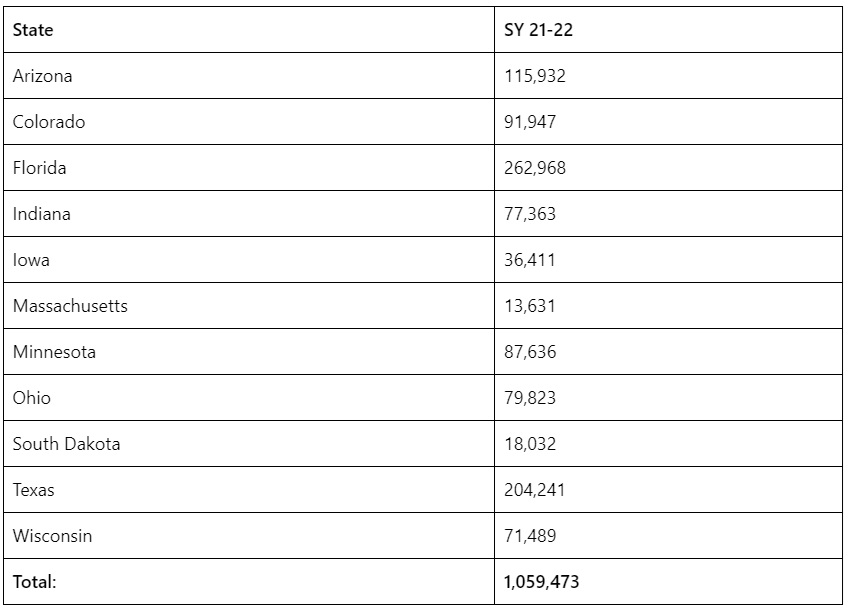Good morning,
This year has been called the year of school choice. In 2023, 16 private or public school choice proposals across 14 states were signed into law. State policymakers are gearing up for their 2024 legislative sessions and school choice is on the menu again. About half of today’s governors fully or partially support school choice policies, according to EdChoice. The governors of Texas, Tennessee, and Oklahoma have already announced their support for passing school choice laws in the upcoming year.
Currently, 32 states have 77 private school choice programs, seven of which are universal or near-universal education savings accounts (ESAs) that parents can use to pay for approved education expenses, such as private school tuition or tutoring. These programs benefited approximately 770,000 students during the 2022-23 school year. The recent growth in school choice victories makes approximately 20 million students eligible to use public dollars for private school tuition.
At the same time, 16 states have robust open enrollment laws, five of which were signed into law during the 2023 legislative sessions. Open enrollment allows students to attend public schools other than their residentially assigned one. Unfortunately, data on the number of students using open enrollment or other public school transfer laws is poor, even in states with strong open enrollment laws. However, of the states with robust open enrollment laws in effect today, more than 9.4 million students could attend a public school other than their residentially assigned, according to enrollment figures from the 2021-22 school year.
In fact, even though 43 states permit some sort of public school transfer under limited circumstances, such as being assigned to a failing school, only 13 states publish the total number of transfer students on their state education agencies’ websites. Reason Foundation was only able to access data for 11 states, showing that more than one million students used open enrollment or some sort of public school transfer law during the 2021-22 school year.
Table 1: Number of Students Using Open Enrollment/Public School Transfer Laws

Source: Reason Foundation
It is worth noting the number of students using open enrollment is likely much higher and rising. For instance, Oklahoma’s data is incomplete, but more than 8,000 public school transfer applications were approved for the 2022-23 school year. Arkansas, Idaho, Montana, North Dakota, and West Virginia adopted robust open enrollment laws earlier this year.
Many states have not published their data regarding student transfers for the 2022-23 school year, but preliminary data from seven of the states in Table 1 show that more than 654,000 students transferred to traditional public schools other than their residentially assigned school.
This hints at a large, but untracked, public school choice sector—kids finding a public school that is a better fit for them than their assigned school. Combined with the 3.5 million students enrolled in charter schools nationwide, and the various private school choice programs, at least 5.2 million students, not including homeschoolers, used school choice during the 2021-22 school year.
This growth and recent legislative successes of various school choice laws underscore a shift in the way many families think about their schooling options and highlight state policymakers’ need to formulate strategies to modernize their K-12 education systems.
Policymakers gearing up for the 2024 legislative sessions should consider how Arizona and West Virginia successfully built their robust school choice sectors.
Arizona’s incremental approach could be ideal in states where families and policymakers are more skeptical of school choice. The Grand Canyon State invested in an array of robust public school choice options in the 1990s, such as charter schools and open enrollment. Once families were used to public school choice, policymakers could successfully introduce private school choice options, such as the nation’s first, albeit limited, ESA in 2011. Arizona policymakers expanded the ESA’s eligibility criteria to include all students in 2023.
While this effort spanned nearly three decades, Arizona’s initial investment in public school choice paid off since demand for flexible education options exploded once families became acclimated to school choice. Over 240,000 Arizona students were enrolled in charter schools and almost 115,000 used open enrollment during the 2021-22 school year, according to data from the Arizona Department of Education. At the same time, nearly 9,700 students used the ESA in 2022, and the program served almost 72,000 participants during the 2023-24 school year. That means 31% of Arizona students using public funds attended the school of their choice during the 2021-22 school year.
At least 12 other states have followed Arizona’s lead, implementing open enrollment and later adopting statewide and robust private school choice policies. On the other hand, 13 states, such as Florida, proceeded in the opposite order, adopting statewide private school choice policies and then later establishing open enrollment.
These incremental approaches could be ideally suited to states that are historically unfriendly to school choice, especially those where local funds make up the lion’s share of K-12 education funds. These initial investments can lay the foundation for robust student-centered cultures, building formidable school choice coalitions, and later producing impressive dividends.
Other states can be ripe for change and make reforms quickly. For example, West Virginia had no private or public school choice options until 2019, when the state enacted its first charter school law. Three years later, the Mountain State established the Hope Scholarship, a near-universal education savings account program. This year, West Virginia policymakers adopted robust open enrollment policies. Thus, in just five years, West Virginia became a leader in school choice policies after lagging behind other states for decades.
Other states, such as Arkansas and Iowa have followed the West Virginia path signing a flurry of expansive school choice proposals into law over a short period. Policymakers should seize these unprecedented opportunities when they arise.
Ultimately, every school choice victory is important–be it rapid or gradual–since it builds a stronger education marketplace that’s student-centered. Expanding school choice policies will only increase demand for greater education freedom as many more families become less financially tethered to government-assigned schools.
With 2024 around the corner, state policymakers should continue to expand school choice policies, so every student can find the education that is the right fit.
From the states
Tennessee Gov. Bill Lee announced his proposal for state education savings accounts which would expand the state’s pilot ESA program to all students at the beginning of the 2025 school year. Currently, 2,000 students living in three counties receive ESAs valued at more than $7,000. The expansion would provide 20,000 scholarships to eligible students.
Policymakers in Wyoming are considering a new ESA proposal that would provide $5,000 scholarships to low-income students. The bill was approved by the state’s Joint Education Committee last month and garnered support from the House Speaker Albert Sommers, who killed a previous ESA proposal in February. Sommers said he supports the new proposal since half of its funds would go to preschoolers.
In Missouri, Rep. Doug Richey prefiled House Bill 1911, which would establish a universal tax-credit scholarship that parents could use to pay for approved education expenses outside of public education. Parents can use the tax-credit to be reimbursed for education expenses.
What to watch
After the Republican-controlled Texas legislature failed to come to an agreement on school choice proposals over several special sessions, Gov. Greg Abbott is seeking political revenge. The governor has only endorsed Republicans who supported his ESA proposal and stated that he would “go after” Republicans who didn’t. According to the Texas Scorecard, run by the conservative advocacy group Empower Texans, every Republican who voted against the proposal is either leaving the legislature or facing a challenger in the primaries.
A lawsuit claiming that Wisconsin’s voucher program is unconstitutional was unanimously rejected by the state Supreme Court. In an unsigned order, the 4-3 liberal-controlled court rejected the lawsuit, which had targeted the nation’s first private school choice program, without comment.
Oklahoma’s private school tax credit is in high demand. Oklahoma received more than 30,000 submissions for the scholarship valued between $5,000 and $7,500 per school year. Recipients can use these funds to pay for approved education expenses, such as private school tuition. The Oklahoman reported that “Little, if any, of the program’s $150 million budget would be left” if all submissions are approved. The program’s budget is set to expand to $200 million and $250 million in 2025 and 2026, respectively. However, House Speaker Charles McCall said that he is confident that the Oklahoma House “would be in favor of accelerating the cap to year-three levels at $250 million.”
Recommended reading
A Nation At Risk +40: A Review of Progress in US Public Education
John D. Singleton at Hoover Institute
“The durability of this increase in demand for choice—particularly as new cohorts of students come of age—will combine with policy developments on the supply side that likewise portend a future with more school choice. In the wake of the COVID-19 pandemic, policy momentum behind expanding private school voucher programs has rapidly gained steam across numerous states.”
Night of the Living Ed: Zombie Public Schools, Drained of Pandemic Lifeblood, Haunt the Land
Vince Bielski at RealClear Investigations
“Since zombie schools don’t cover their own expenses, superintendents have to pull resources from other schools and programs to subsidize them. Funding for art, music, special education, and advanced placement classes may be cut, affecting students throughout the district.”
St. Louis-Area School District Aggressively Audits Student Housing, Citing ‘Educational Larceny’
Kavahn Mansouri and Kate Grumke at St. Louis Public Radio
“Residency investigations have increased sharply in the Hazelwood School District over the past five years, along with the number of home visits the school’s residency investigation team makes — a practice Fink and colleagues said is intrusive and violates privacy.”

